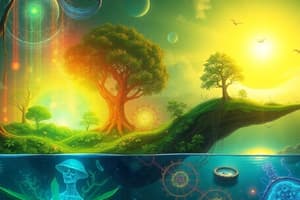Podcast
Questions and Answers
What are the key ingredients for photosynthesis and where does this process primarily occur?
What are the key ingredients for photosynthesis and where does this process primarily occur?
The key ingredients for photosynthesis are carbon dioxide, water, and sunlight, and it primarily occurs in the chloroplasts of plant cells.
Explain the difference between aerobic and anaerobic respiration. Include their locations.
Explain the difference between aerobic and anaerobic respiration. Include their locations.
Aerobic respiration requires oxygen and occurs in mitochondria, while anaerobic respiration occurs without oxygen and takes place in the cytoplasm.
What role do mineral nutrients play in plant nutrition, and what are the two types of nutrients?
What role do mineral nutrients play in plant nutrition, and what are the two types of nutrients?
Mineral nutrients are crucial for plant health, aiding in growth and development. The two types of nutrients are macronutrients, needed in large amounts, and micronutrients, needed in smaller quantities.
Describe the different types of nutrition in animals and give an example of each.
Describe the different types of nutrition in animals and give an example of each.
How do the xylem and phloem differ in their functions within plant transport systems?
How do the xylem and phloem differ in their functions within plant transport systems?
What is the process of transpiration, and how does it assist in water transport in plants?
What is the process of transpiration, and how does it assist in water transport in plants?
What is the importance of excretion in organisms?
What is the importance of excretion in organisms?
Summarize the overall significance of photosynthesis in ecosystems.
Summarize the overall significance of photosynthesis in ecosystems.
Flashcards are hidden until you start studying
Study Notes
Life Processes Study Notes
Photosynthesis
- Definition: Process by which green plants and some other organisms convert light energy into chemical energy.
- Key Ingredients: Carbon dioxide, water, and sunlight.
- Location: Occurs primarily in chloroplasts of plant cells.
- Chemical Equation:
- 6 CO₂ + 6 H₂O + light energy → C₆H₁₂O₆ + 6 O₂ (Glucose + Oxygen)
- Importance:
- Produces oxygen essential for most life forms.
- Basis of the food chain; provides energy for plants and, indirectly, for animals.
Respiration
- Definition: The biochemical process of breaking down glucose to release energy.
- Types:
- Aerobic: Requires oxygen (glucose + oxygen → carbon dioxide + water + energy).
- Anaerobic: Occurs without oxygen (glucose → lactic acid + energy or alcohol + carbon dioxide + energy).
- Location: Cytoplasm (anaerobic) and mitochondria (aerobic) of cells.
- Importance:
- Energy production for cellular functions.
- Supports growth, reproduction, and active transport in cells.
Nutrition in Plants
- Autotrophic nutrition: Plants produce their own food through photosynthesis.
- Mineral nutrients: Minerals absorbed from soil are crucial for plant health (nitrogen, phosphorus, potassium).
- Types of Nutrients:
- Macronutrients: Needed in large amounts (N, P, K).
- Micronutrients: Needed in smaller quantities (iron, zinc, etc.).
- Feeding Mechanism:
- Root system absorbs water and minerals.
- Leaves capture sunlight for photosynthesis.
Nutrition in Animals
- Heterotrophic nutrition: Animals obtain food by consuming other organisms.
- Types of Nutrition:
- Herbivores: Eat plants.
- Carnivores: Eat animals.
- Omnivores: Eat both plants and animals.
- Digestive Process: Involves ingestion, digestion (mechanical and chemical), absorption, and egestion.
- Importance of Nutrition:
- Provides energy for metabolic processes.
- Essential for growth, repair, and reproduction.
Transport in Plants
- Transport Systems:
- Xylem: Transports water and dissolved minerals from roots to leaves.
- Phloem: Transports organic nutrients (sugars) from leaves to other parts of the plant.
- Mechanisms:
- Transpiration: Loss of water vapor from leaves creates a negative pressure, aiding water movement up through the plant.
- Active transport: Required for nutrient uptake against concentration gradients.
Excretion
- Definition: The removal of metabolic waste products from an organism.
- Importance:
- Maintains internal homeostasis.
- Prevents toxic accumulation of wastes.
- Excretory Organs:
- In plants: Stomata (loss of gases), roots (excess ions), and leaf abscission.
- In animals: Kidneys (urine formation), lungs (carbon dioxide), skin (sweat).
- Types of Waste:
- Nitrogenous wastes: Urea (in mammals), uric acid (in birds), ammonia (in aquatic animals).
Photosynthesis
- Green plants and some organisms convert light energy into chemical energy.
- This process requires carbon dioxide, water, and sunlight.
- Photosynthesis takes place primarily in chloroplasts of plant cells.
- The chemical reaction is: 6 CO₂ + 6 H₂O + light energy → C₆H₁₂O₆ + 6 O₂
- Photosynthesis creates oxygen essential for most life and forms the basis of the food chain.
Respiration
- Respiration is the biochemical process that breaks down glucose to release energy.
- Aerobic respiration requires oxygen and produces carbon dioxide, water, and energy.
- Anaerobic respiration occurs without oxygen and produces either lactic acid and energy or alcohol, carbon dioxide, and energy.
- Respiration takes place in the cytoplasm (anaerobic) and mitochondria (aerobic) of cells.
- It provides energy for cellular functions, growth, reproduction, and active transport in cells.
Nutrition in Plants
- Plants are autotrophs because they produce their own food through photosynthesis.
- Plants require mineral nutrients from the soil, such as nitrogen, phosphorus, potassium, and micronutrients like iron and zinc, for optimal growth.
- Roots absorb water and minerals from the soil, while leaves capture sunlight for photosynthesis.
Nutrition in Animals
- Animals are heterotrophs and obtain food by consuming other organisms.
- Animals can be herbivores, carnivores, or omnivores.
- The digestive process in animals includes ingestion, digestion (mechanical and chemical), absorption, and egestion.
- Nutrition provides energy for metabolic processes and is essential for growth, repair, and reproduction.
Transport in Plants
- The xylem transports water and dissolved minerals from roots to leaves.
- The phloem transports organic nutrients (sugars) from leaves to other parts of the plant.
- Transpiration, the loss of water vapor from leaves, creates a negative pressure that aids water movement up through the plant.
- Active transport is necessary for nutrient uptake against concentration gradients.
Excretion
- Excretion is the removal of metabolic waste products from an organism.
- It maintains internal homeostasis and prevents the toxic accumulation of wastes.
- Plants excrete waste through stomata (gases), roots (excess ions), and leaf abscission.
- Animals excrete waste via kidneys (urine formation), lungs (carbon dioxide), and skin (sweat).
- Nitrogenous wastes include urea (mammals), uric acid (birds), and ammonia (aquatic animals).
Studying That Suits You
Use AI to generate personalized quizzes and flashcards to suit your learning preferences.




